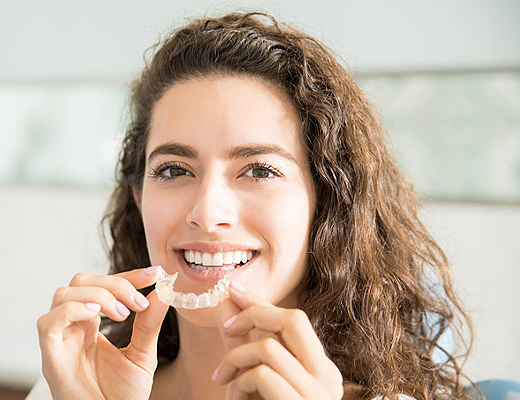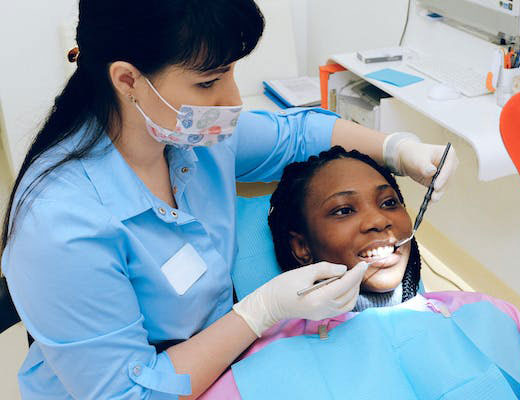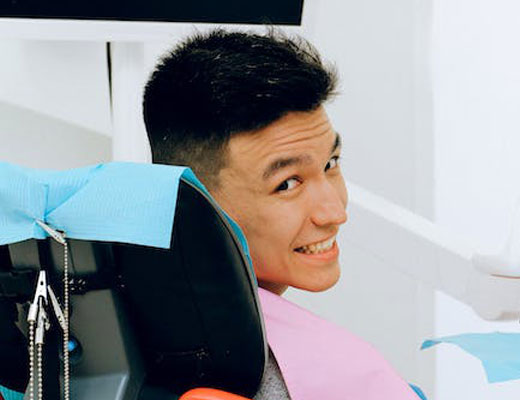Services
Invisalign
Invisalign is an invisible braces option that straightens your smile using a series of clear aligners. Find your way to a straighter smile with Invisalign and our help. Introduced in 1998, Invisalign clear aligners are a popular choice if you’re hoping to straighten your smile.
Unlike traditional braces, they can be worn over the teeth without calling attention to their presence. Everyone wants a great smile and with Invisalign you can have just that. Please feel free to reach out to us for more information on how we can meet your needs. Keep in mind that even if you’ve already got a lovely smile, we can help you keep it that way.
Dental Implants
Missing teeth can take a toll on your confidence and oral health. Fortunately, dental implants offer a revolutionary solution, acting as permanent replacements for lost teeth and bringing back that healthy, complete smile.
What are dental implants?
Think of them as artificial tooth roots. These small, biocompatible posts, usually made of titanium, are surgically placed into the jawbone. Over time, a process called osseointegration bonds the implant with the bone, creating a sturdy foundation for a crown, bridge, or even dentures.
Cosmetic Dentistry
Cosmetic dentistry is a specialized branch of dental care that focuses on improving the aesthetics of teeth, gums, and the overall smile.
Through a variety of procedures, cosmetic dentists aim to enhance the appearance of teeth, address imperfections, and create a more attractive and confident smile.
If you are considering cosmetic dentistry procedures, consulting a qualified cosmetic dentist is crucial to discuss your aesthetic goals and determine the most appropriate treatment plan.
Hygiene / Periodontal Health
Dental hygiene is the practice of maintaining dental health. It involves basic efforts like brushing and flossing and other practices like visiting the dentist and fixing dental issues. Proper dental hygiene can lead to a brighter smile, fewer dental concerns, and more!
While it’s important to take care of your teeth, it’s equally important to pay attention to your gums. The stronger your gums are, the better your oral health will be.
Periodontal disease can run the gamut in terms of severity, but regardless, it’s important to know what kind of treatment is available. Acting quickly can help you avoid a structural breakdown.
Dental Bondings and White Fillings
Dental Bondings:
Dental bonding involves applying a durable plastic putty to the tooth and drying it under ultraviolet light, which bonds the material to the surface of the tooth. Bonding is used to repair chipped or cracked teeth as well as to cover severe discoloration.
White Fillings:
White fillings are made of composite resin and serve to fill cavities. They can be matched to your existing teeth and aren’t affected by temperature changes.
Dental Crowns
Dental crowns are similar to veneers, but instead of simply covering the front of the tooth, they encase both the front and the back of the tooth.
This option is typically used on to keep cracked or otherwise very weak teeth in place.
Crowns can be made from ceramic composites, porcelain, or resin.
From basic preventive treatments to crowns our services cover the full spectrum of achieving a healthy, happy smile.
Veneers
Dental veneers are porcelain or resin shells designed to cover the surface area of damaged teeth. Veneers are bonded to the front portion of the tooth after removing about a half millimeter of enamel.
Veneers can be customized to meet color and shape preferences and are used on multiple as well as single teeth.
Dental Bridges
Dental bridges allow gaps between your teeth due to extractions to be filled in an aesthetic, functional way. A dental bridge is mounted on existing teeth with a prosthetic tooth between them.
Dental bridges are still used in certain circumstances, but 21st-century dental technology has reduced the need for dental bridges. However, this option is still useful when patients don’t have sufficient bone material to make dental implants a viable choice.
Teeth Whitening
Teeth whitening is among the most requested cosmetic dentistry services. After all, who doesn’t love a bright, shining smile?
There are a variety of teeth whitening techniques available at your dentist’s office that are safe and effective for the vast majority of people. Treatments range from prescription-strength whitening kits that patients use at home to chairside bleaching to state-of-the-art laser technology. Talk with our dentists to see which whitening options are right for you.
Extractions
Tooth extractions are a common dental procedure that involves removing a tooth from the mouth. While dentists always strive to preserve natural teeth, there are times when extraction is the best course of treatment.
Here are some common reasons why a tooth extraction might be necessary:
Severe tooth decay: If a tooth is severely decayed and cannot be repaired with a filling or crown, extraction may be necessary to prevent the infection from spreading to other teeth.
Impacted tooth: An impacted tooth is a tooth that is unable to erupt through the gum line. This can cause pain, infection, and damage to other teeth. Impacted wisdom teeth are the most common type of impacted teeth.
Gum disease: Severe gum disease can damage the tissues that support the teeth, causing them to loosen and fall out. In some cases, tooth extraction may be necessary to prevent further tooth loss.
Fractured tooth: A tooth that is fractured beyond repair may need to be extracted to prevent pain and infection.
Overcrowding: In some cases, there may not be enough space in the mouth for all of the teeth. Extracting one or more teeth can create space for the remaining teeth to properly align.
Dentures / Partial Dentures
Missing teeth can impact not just your smile, but also your ability to chew and speak clearly.
Dentures offer a reliable solution, replacing missing teeth and restoring lost function.
There are two main types:
Complete Dentures and Partial Dentures.
Complete dentures are used when all teeth in an upper or lower jaw, or both, are missing.
They are custom-made to fit snugly against the gums, with a base that resembles gum tissue and replacement teeth crafted from acrylic or porcelain.
Complete dentures improve chewing and speaking ability, and can enhance facial appearance by supporting the cheeks and lips.
Partial dentures, on the other hand, are for individuals with some remaining natural teeth.
These removable appliances fill in gaps created by missing teeth, preventing surrounding teeth from shifting and improving bite function.
Partial dentures typically consist of replacement teeth attached to a gum-colored plastic base, often with metal clasps that secure them to the natural teeth.
Root Canal
When a toothache strikes, the mere mention of a root canal can send shivers down the spine. But don’t let fear lead to tooth loss. A root canal is often a tooth hero, restoring health and function while preventing the need for extraction.
Inside each tooth lies a delicate pulp chamber, containing nerves, blood vessels, and connective tissue. When infection or inflammation strikes this pulp, pain, sensitivity, and swelling can ensue. A root canal addresses this by removing the diseased pulp and cleaning the root canals, preventing infection from spreading and saving the tooth.
The Process:
Numbing the Area: Local anesthetic ensures a comfortable experience.
Accessing the Pulp: A small opening is created in the tooth’s crown.
Removing the Pulp: Delicate instruments extract the inflamed pulp.
Cleaning and Shaping: Root canals are meticulously cleaned and shaped.
Filling and Sealing: A biocompatible material securely fills and seals the canals.
Restoring the Crown: A crown or filling protects the tooth and restores its function.
Laser Dentistry
Dentists around the world are discovering the many benefits of laser dentistry. Dental lasers are for soft, hard, and osseous tissue. Patients can now experience more comfortable, fast, precise and virtually pain-free procedures. That’s because dental lasers are an anxiety-free and pain-free dental technology that allows you to go through any dental procedure with ease and without dental phobia.
Plus, you will not get numb gums, cheeks, and lips as is the case with local anesthesia.
Contact us for more information on the dental laser and how it works.














